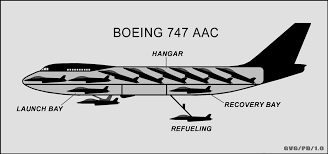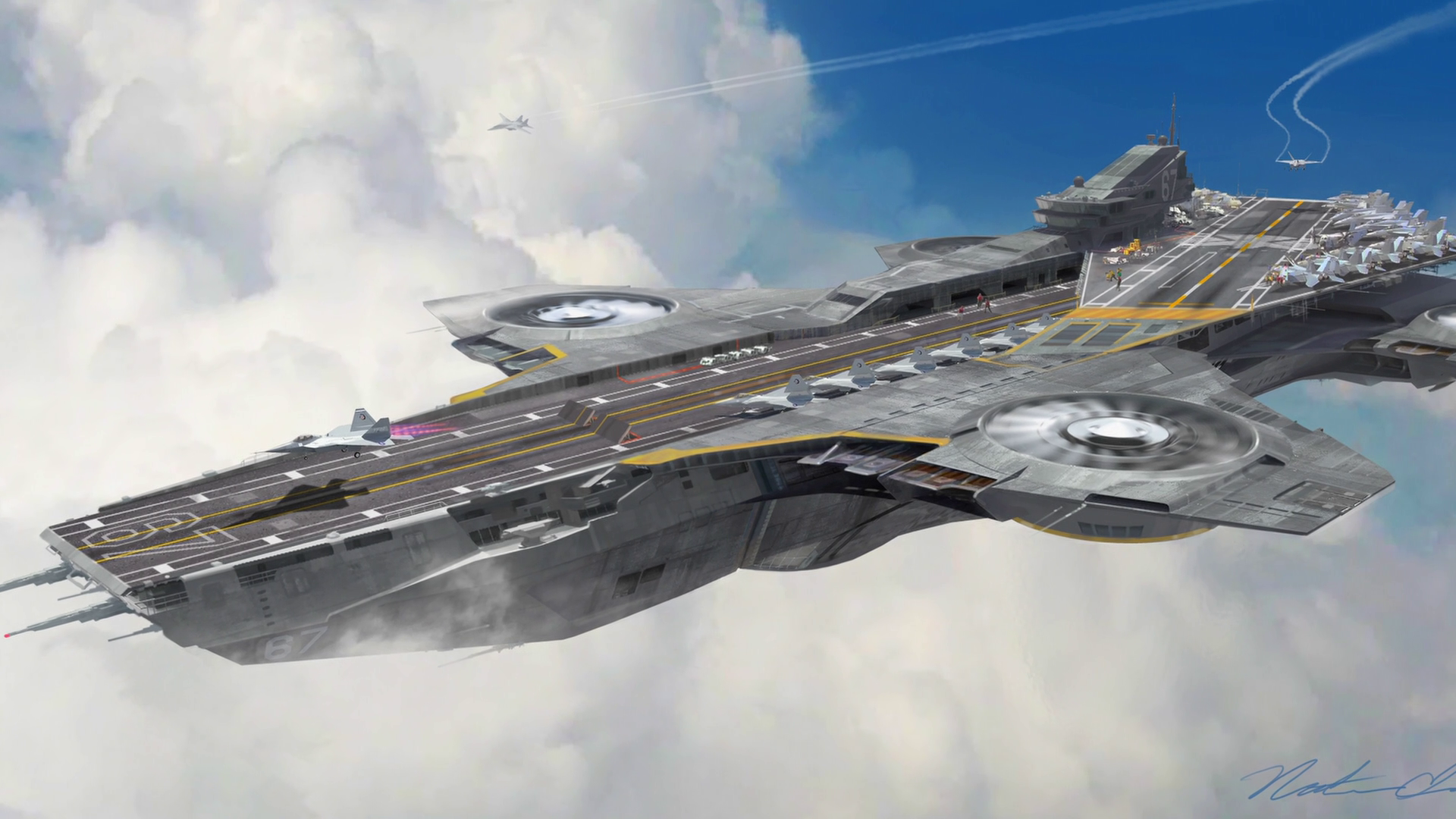美軍正在研發可在空中飛行的航空母艦
茉莉花園
452 回覆
464 Like
12 Dislike
茉莉花園
2021-03-28 11:34:43
AIRCRAFT-CARRIERS are juicy targets. They are also increasingly vulnerable ones. Like medieval castles in the age of the cannon, technological advance threatens to make them redundant. Satellites and over-the-horizon radars mean pinpointing their locations is easier. And a single well-aimed, well-armed missile may be enough to render a carrier useless, even if one shot does not sink it outright.
American naval planners are particularly worried about China’s DF-26. This weapon, which came into service in 2018, is a so-called manoeuvring ballistic missile (meaning it can vary its final approach path, rather than being subject solely to the laws of gravity) that has been dubbed a “carrier killer”. The DF-26 can be launched from a lorry, and can carry either a conventional or a nuclear warhead.
This threat is fearsome enough to keep American carriers at least 1,600km from China’s coast, reckons Bryan Clark, a naval strategist at the Hudson Institute, a think-tank. That is much farther than the range of a carrier’s warplanes unless they can be refuelled in-flight. America’s Department of Defence is therefore looking for a workaround. One back-to-the-future idea being tested (it dates, originally, from 1917) is to turn a suitable plane into an aerial aircraft-carrier capable of launching and recovering uncrewed drones in flight. This would allow seaborne carriers to be kept well out of harm’s way.
啜貓咪魔人
2021-03-28 11:35:01
avengers

茉莉花園
2021-03-28 11:35:38
Castles in the sky
To that end DARPA, the defence department’s advanced research projects agency, is running a programme called Gremlins, a name that also applies to the individual drones themselves. A Gremlin drone weighs 680kg and has a wingspan of nearly 3.5 metres. Once it has been dropped, deployed its wings and fired up its turbofan engine, it can fly to an area up to 500km away and in the words of Scott Wierzbanowski, the Gremlin programme’s head, “go in and create havoc”. That done, it would then return to its aerial mothership.
Gremlins would operate in fleets, under ultimate human control. In this, they are similar to the “loyal wingman” idea of drone squadrons accompanying a crewed fighter aircraft into battle. Loyal wingmen, however, would take off from and land on terra firma, or possibly a conventional, naval, aircraft-carrier. Operational Gremlins need never touch the ground.
Gremlins’ principal jobs would be intercepting communications, jamming signals and hunting for things to be destroyed, thus softening up the defences in contested airspace to make it safer for crewed aircraft. Such drones could also be armed with small missiles or explosives for a kamikaze attack. And they would both share data and co-operate among themselves, and pass reconnaissance and targeting information back to warships and aircraft able to fire bigger missiles than they could carry.
Gremlin swarms would no doubt suffer losses. But drawing enemy fire would actually be an objective, says Andrew Krepinevich, the boss of a defence consultancy called Solarium, which advises the defence department on aspects of naval and aerial warfare. This way, Gremlins would flush out the position of any hostile missile battery that switched on its targeting radar, marking it for subsequent destruction.
In the calculus of combat, sacrificing a drone or two to knock out an enemy air-defence battery makes for a nice swap. Gremlins should therefore be thought of as “tradable” for systems of greater value, says Mr Wierzbanowski. The better to fool the foe, military planners also envisage air-launched drones that mimic the radar and heat signatures of bigger fighter jets and bombers. This would be done by using shapes and materials that reflect rather than absorbing radar pings, and by leaving an engine’s heat signature unmasked. The illusion could be enhanced by flying drones at speeds and in patterns indicative of larger aircraft.
格雷的五十杯奶茶
2021-03-28 11:36:17
正在研發?我覺得一早整好

最長最型棍
2021-03-28 11:36:20
想引某國軍備競賽

H之後就是愛(I)
2021-03-28 11:36:30
茉莉花園
2021-03-28 11:37:07
On top of all this, a defender’s need to squander precious attention and pricey missiles on incoming cheap drones will give its adversary’s more capable aircraft freer rein. Enthusiasts for air-launched drones therefore see value in numbers. Putting lots of blips on radar screens is a good way to fluster an enemy with “complexity and multiple dilemmas”, says Tim Keeter, who manages the Gremlins programme at Dynetics, DARPA’s principal contractor for the project.
To that end, costs must be kept low. The defence department plans to pay less than $800,000 a pop for Gremlins, though that would be for an order of 1,000 of them. So, if a couple were shot down in an operation, “that’s okay, it really doesn’t matter,” says Mr Wierzbanowski. In military jargon, he describes the things as “attritable”. Dynetics’ working assumption is that each Gremlin will fly a maximum of about 20 missions. This means they can be made from less durable, and therefore cheaper materials and components.
The aerial aircraft-carrier of choice for the Gremlin project is a modified C-130 cargo plane, which could carry up to four of the drones in bomb racks slung under its wings. That would make for a small squadron, but numbers could be bolstered by further drones dropped from accompanying fighters or bombers. Deploying the drones is therefore fairly easy. The tricky part is fishing them out of the air when they return from a mission. For this, Dynetics has designed a special recovery system that fits above a C-130’s cargo ramp.
美利堅特別行政區
2021-03-28 11:37:15
研究左好多n年啦
茉莉花園
2021-03-28 11:37:26
When a Gremlin flies back to the mothership, the cargo ramp opens and the recovery system lowers a boom out of it. This boom releases a pod on a ten-metre-long tether, and that pod clamps onto a short engagement arm which pops out of the top of the Gremlin itself. A successful capture shuts off the Gremlin’s engine. A winch then hoists the drone on board. This arrangement should be able to pull eight Gremlins an hour out of the air.
That, at least, is the idea. So far, though Gremlins have managed to come within centimetres of successful capture, such capture has not been achieved. But Dynetics hopes some software tweaks will deal with this by the summer, when operational testing of the Gremlins system by the air force is supposed to begin.
This testing will include flights with various sorts of payloads. But the most important thing to be tested will be how well Gremlins are able to co-operate—for instance, by swapping tasks as circumstances evolve. For this, the air force is developing software that emerged from a different DARPA programme, called Collaborative Operations in Denied Environment. It will not be able to orchestrate a fully autonomous “swarm”, at least for now. The goal, rather, is to give individual drones enough autonomy for a single human operator to be able to oversee a cluster of them.
The Gremlin-mothership arrangement is distinguished by its scale. But several smaller versions of the underlying idea are also in development. One is being put together by General Atomics, the maker of Predator drones. Predators are showing their age, but General Atomics hopes to breathe new life into them by producing a version that is a mothership for smaller drones called Sparrowhawks that will carry intelligence, surveillance and reconnaissance equipment, electronic-jamming apparatus and possibly explosives. Flight tests began in September 2020, though Sparrowhawks have yet to be air-launched and the firm has not explained how they will be recovered in-flight.
茉莉花園
2021-03-28 11:37:44
Sparrowhawk’s ma’am
The American army, for its part, plans to use helicopters fitted with drone-launching pneumatic tubes as motherships. These drones, which, like Gremlins, unfold their wings after launch, have a wingspan of 2.5 metres. In a test conducted last summer six such drones launched in flight were recovered in the air, albeit not by the Black Hawk from which they had emanated. Rather, they were snared by a quadcopter drone dangling a cord that snagged hooks on the target drones’ wings. In May the army plans to use rail catapults to launch bigger drones from helicopters.
As with Gremlins and Sparrowhawks, the army’s push for what it calls “air-launched effects” is driven by America’s shift from counterinsurgency to potential war with a foreign power. Advances in the ability of Chinese and Russian radars to pinpoint troops and aircraft supporting them is a particular concern, says Lieutenant-Colonel Anthony Freude, who is overseeing the technology’s development at the Army Futures Command, in Alabama. This will push army helicopters back from the front line, he says, so they will disgorge numerous drones that will zip ahead instead. They are to hunt for targets, distract the enemy, and serve as an extra communications network. The capability should be operational in less than three years.
Aerial aircraft-carriers of these sorts do have drawbacks. Snatching drones from midair eats up precious time. That and the manoeuvring required could make it easier for an enemy to shoot down a mothership. But drones that can be reused 20 times offer advantages, not least of cost, over expendable single-shot alternatives.
Castle builders solved the problems brought by cannons by redesigning fortresses to be low, thick-walled and protected by bastions. That worked well. Whether launching aircraft-carriers into the sky will be an equally successful response to technological advance remains to be seen. ■
滅共主角
2021-03-28 11:37:58
研究到反重力?


上車前將嬰兒摺起
2021-03-28 11:38:09
講得出搞掂左
非人類
2021-03-28 11:38:37
唔係新概念,不過以前技術上有難度

劍無痕
2021-03-28 11:38:39
唔好打J喇,呢的根本無戰略價值
海派甜心
2021-03-28 11:38:53
中國架近岸航空母艦係咪仲要長期泊岸

隨風成對
2021-03-28 11:39:28
又係核能果d fd
老老尻
2021-03-28 11:39:52
整呢種不如整軍事太空站

呀.......
2021-03-28 11:39:53
咁海上既航空母艦咪廢左


?
沉溺需要深
2021-03-28 11:41:14
飛空艇


















 ?
?